Warship Wednesday, Nov. 22, 2023: From Midway to Trafalgar
Here at LSOZI, we take off every Wednesday for a look at the old steam/diesel navies of the 1833-1954 period and will profile a different ship each week. These ships have a life, a tale all their own, which sometimes takes them to the strangest places. – Christopher Eger
Warship Wednesday, Nov. 22, 2023: From Midway to Trafalgar
Above we see a great bow-on shot of the FRAM’d Gearing class destroyer USS Eugene A. Greene (DD/DDR-711)with a bone in her teeth in her second life as the Spanish Navy’s Churruca (D61) in the 1980s, the country’s traditional crimson and gold Rojigualda ensign on her mast, a twin 5″/38 hood ornament and two forward-facing Mk.32 triple torpedo tubes under the bridge wings. Her original moniker comes from naval aviator Eugene Allen Green, born 98 years ago this week.
The Gearings
In July 1942 the U.S. Navy, fighting a U-boat horde in the Atlantic and the Combined Fleet in the Pacific was losing ships faster than any admiral ever feared in his worst nightmare. With that in mind, the Navy needed a lot of destroyers. While the Fletcher and Allen M. Sumner classes were being built en mass, the go-ahead for some 156 new and improved Sumners— stretched some 14 feet to allow for more fuel and thus longer legs to get to those far-off battlegrounds– was given. This simple mod led to these ships originally being considered “long hull Sumners.”
These hardy 3,500-ton/390-foot-long tin cans, the Gearing class, were soon being laid down in nine different yards across the country.
Designed to carry three twin 5-inch/38 cal DP mounts, two dozen 40mm and 20mm AAA guns, depth charge racks and projectors for submarine work, and an impressive battery of 10 21-inch torpedo tubes (downgraded to just 5 tubes) capable of blowing the bottom out of a battleship provided they could get close enough, they were well-armed. Fast at over 36 knots, they could race into and away from danger when needed.
Meet Eugene A. Greene
Our subject is the first Navy ship to be named in honor of Eugene Allen Green, born in Smithtown, New York on 21 November 1921. A 1940 graduate of Rhode Island State College, he attended ROTC while in school and promptly enlisted in the U.S. Navy Reserve’s air cadet program, earning his ensign bar along with his wings of gold by August 1941.
Assigned to Bombing (VB) Six aboard USS Enterprise (CV-6) in March 1942, he gave his last full measure behind the controls of his SBD (6-B-9) at the ripe old age of 21 during the Battle of Midway when, following the attack by VB-6 against the aircraft carrier Kaga on 4 June, he was one of 14 of the “Big E’s” pilots that had to ditch their planes on the way back home, out of fuel. Greene and his gunner, RM3c SA Mutane, along with the crews of eight other ditched aircraft from Enterprise that day, would never be seen again.
Greene was granted a posthumous Navy Cross in December 1942 and his widow, Mrs. Anita M. Greene, would sponsor the destroyer named in his honor.
The second of 16 Gearings contracted via Federal Shipbuilding, Kearny, New Jersey, the future USS Eugene A. Greene (DD-711) was laid down on 17 August 1944, launched the following March, and commissioned on 8 June 1945.
War!
While 98 Gearings would eventually be completed, most of these arrived too late to take part in WWII, with Greene joining a club that only included 44 sisters who arrived very late in the war. Although some were present in the final push to Tokyo, none were damaged or lost. Three of the class– USS Frank Knox, Southerland, and Perkins— entered Tokyo Bay in time to be present at the Japanese surrender, on 2 September 1945.
As for Greene, her WWII service, as detailed by her War History, consisted primarily of a shakedown cruise ranging from Penobscot Bay, Maine to Guantanamo Bay then, in mid-August following the news of the Japanese surrender, was assigned to the Atlantic fleet to serve as a school ship in Norfolk and Casco Bay, then to Pensacola to assist as a plane guard for aviation cadets– a task she would be well-versed in over her career.

USS Eugene A. Greene (DD-711) off New York City on 29 May 1946. She is still painted in wartime Camouflage Measure 22. NH 66345
A Chilly Peace
As the Navy’s newest destroyers, none of the new Gearings were mothballed after the war.
On 13 February 1947, Greene sailed south in a task group bound for Montevideo, Uruguay, to participate in the festivities accompanying the inauguration of the country’s new president, Tomás Berreta. The group also paid a goodwill visit to Rio de Janeiro before returning to Norfolk on 31 March.

Light cruiser USS Fresno (CL-121) on port call at Rio De Janeiro, March 1947, alongside her Gearing class consorts, USS Gearing, USS Gyatt, and USS Eugene A. Greene. Note the stern depth charge racks. The quartet was returning from Uruguay where they represented the U.S. at the inauguration of the new Uruguayan president. The Fresno was launched in 1946, too late to serve in WWII, so she took part in good-will diplomatic missions like this. She was sold for scrap in 1966. Photo attributed to Robert Norville, from NavSource.
As detailed by DANFS, the Norfolk-based Greene then became a staple of the 6th Fleet until 1960:
On 10 November 1947, Eugene A. Greene sailed on the first of 9 Mediterranean cruises made over the next 13 years. During those years, she and her sisters of the U.S. 6th Fleet have guarded the interests of peace and order in that sea which was the cradle of democratic government. Voyages to northern Europe and the Arctic varied the routine of overseas deployment for Eugene A. Greene.
What was skipped by DANFS was the fact that Greene was on hand in the region for five months through the 1956 Suez Crisis just in case she was needed.
It should be noted that, by this stage, she was significantly modernized, picking up a new tripod mast with AN/SPS-6 L-band radar (later augmented by an SPS-8A S-band capable of spotting aircraft 60nm away) and lightened her topside by landing most of her WWII AAA suite, torpedoes, and depth charges. This resulted in a change to a destroyer radar picket (DDR-711) that she held from July 1952 until she reverted to the simpler DD-711 in March 1963.
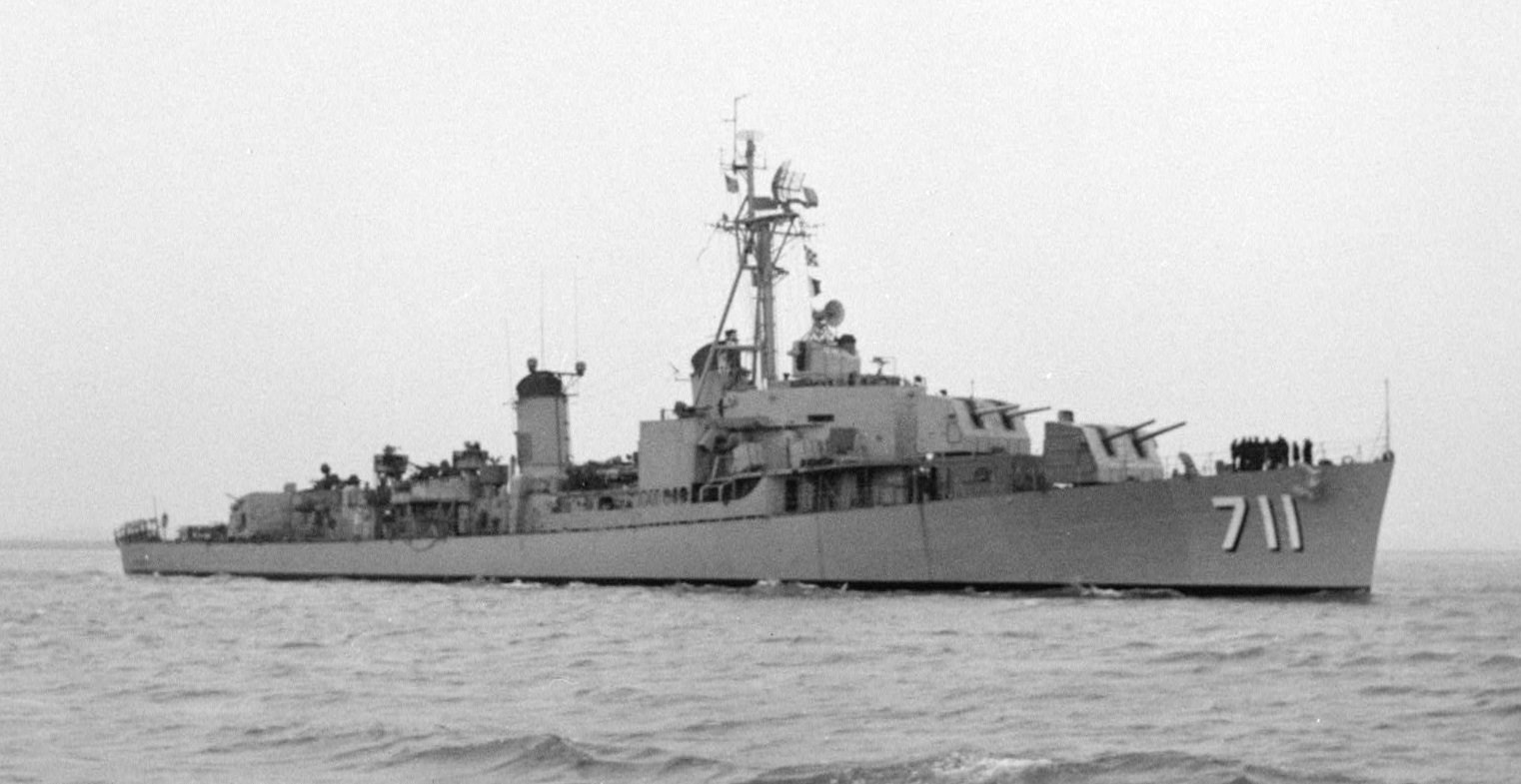
USS Eugene A. Greene (DD-711) underway at sea on 19 September 1950. Note that she has received a new tripod mast with AN/SPS-6 radar and has landed much of her WWII AAA suite, torpedoes, and depth charges. National Archives Identifier 24743125
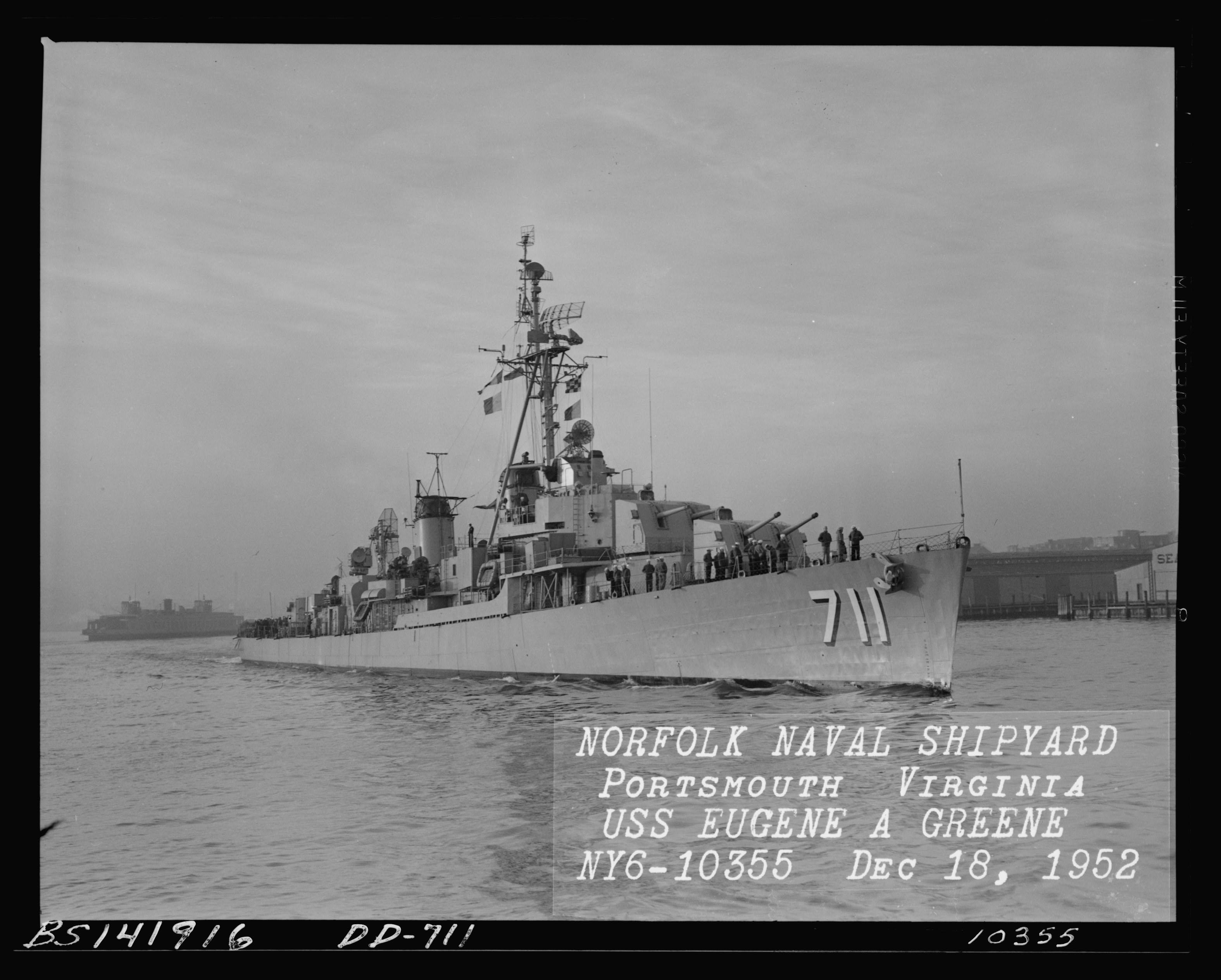
USS Eugene A. Greene (DDR-711) off the Norfolk Naval Shipyard on 18 December 1952. National Archives Identifier 24743145
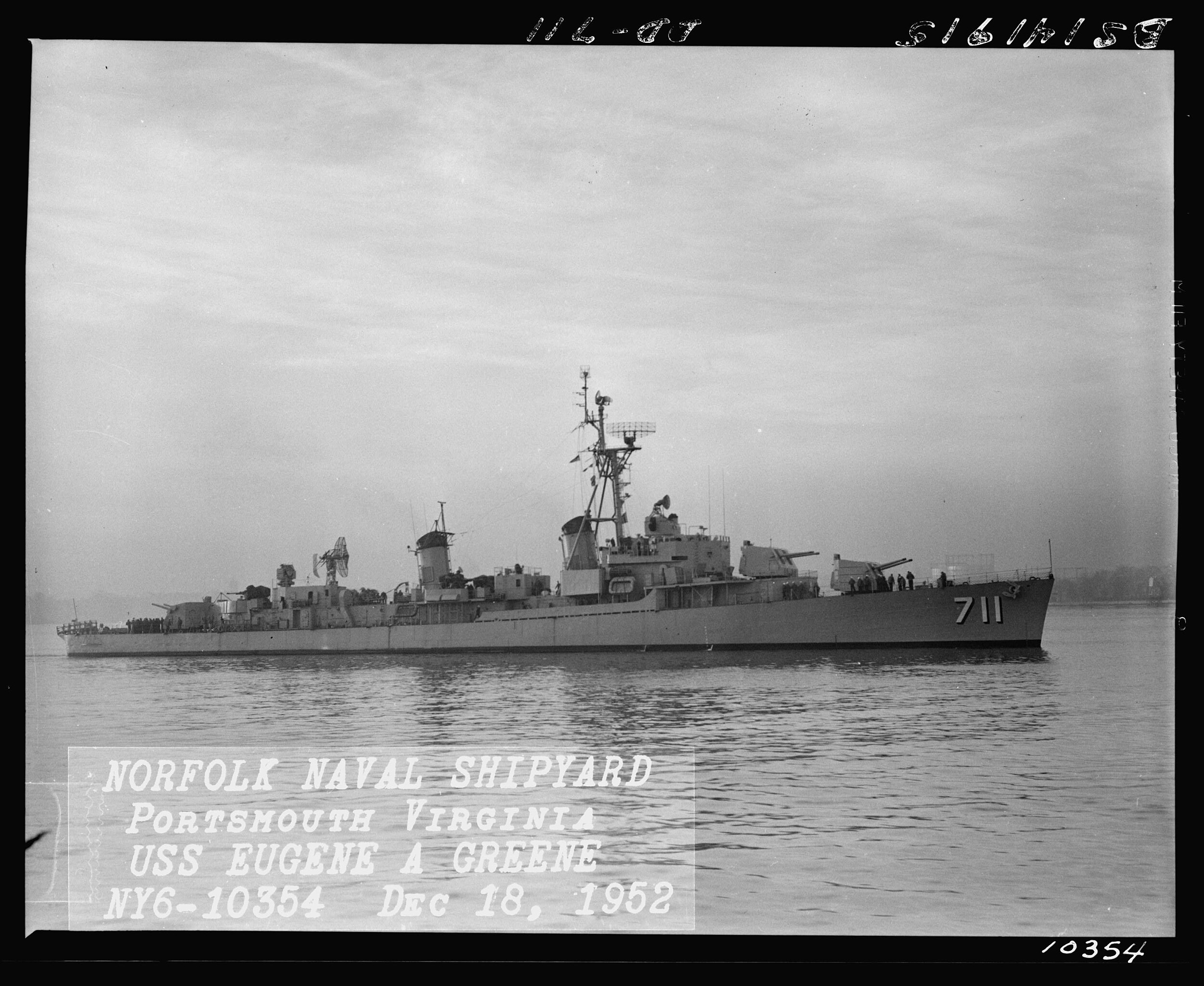
Same as the above, stb profile. Note the newly installed AN/SPS-8 air search radar aft for her role as a DDR picket. 24743143
The Frostiest Part of the Cold War
Greene experienced the life that came with all the classic 1960s naval adventures in the Atlantic.
Greene is on the list of U.S. Navy ships that received the Armed Forces Expeditionary Medal for participating in the Cuban quarantine, from 24 October through 20 November 1962.
Roger Powell missed ship’s movement of the destroyer USS Rush (DD-714) — along with 44 other shipmates as she sortied out over the weekend on little notice– and was tacked on to help fill out Greene’s crew, similarly, headed for Cuba to be a plane guard alongside the USS Enterprise.
Greene would undergo a nearly year-long FRAM I reconstruction at Boston NSY, completed in October 1963. Meant to add 8 years to the ship’s life via a complete rehabilitation of all shipboard components, it also fundamentally changed the destroyer to a modern sub-buster. The 5″/38 Mount 52 forward was removed during the rebuild while a hangar and platform for the QH-50C DASH ASW drone was added in place of the SPS-8A radar house.
Also new was an 8-cell ASROC matchbox launcher amidships, SQS-23 SONAR, VDS, and a six-pack of Mark 32 torpedo tubes. She added Mk 44 ASW torps to her magazine, for use by her own Mk32s as well as DASH, which theoretically could drop them some 20 miles away from the destroyer.
When she left Boston, she became first the flag of Destroyer Squadron 28, then DESRON 32.
Like most East Coast-based Navy ships in the era, Greene participated in several NASA recovery missions between other assignments, logging two (Mercury-Atlas 2 and 3) in early 1961 and Gemini-Titan 2 (GT-2) in 1965, supporting the primary recovery ship, USS Lake Champlain (CVS-39).
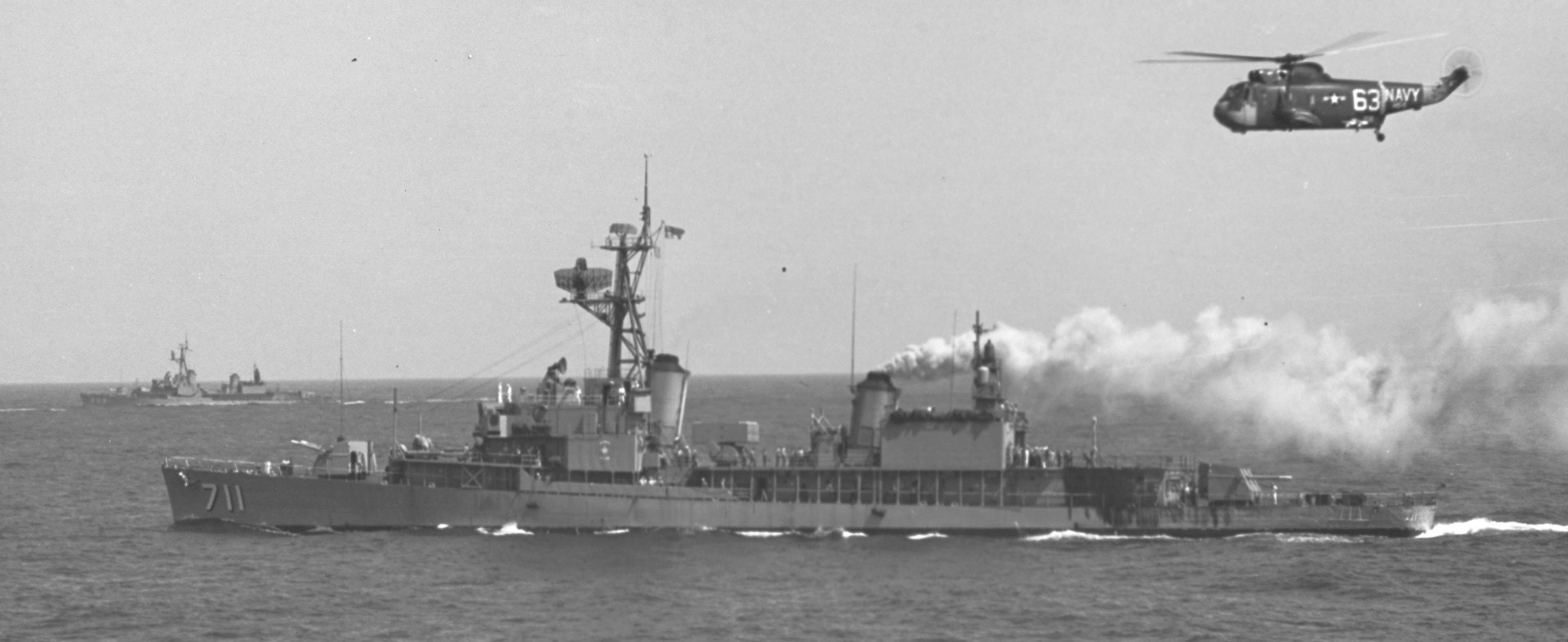
A great view of the post-FRAM’d USS Eugene A. Greene (DD-711) steaming past USS Lake Champlain (CVS-39) during operations on 23 September 1964. Note her ASROC amidships and her big DASH hangar aft in place of the deleted Mount 52. She still carries her aft mount (Mount 53) and forward (51). One of the carrier’s big Sikorsky SH-3 Sea King ASW helicopters is flying by in the right foreground, and another destroyer is in the left distance. Photographer: AN Thomas J. Parrett. NH 107007
Speaking of the Med, Greene would make another four deployments there between 1968 and 1972– and on two of them job into the Persian Gulf/Indian Ocean to show the flag in the increasingly important region. This included a seven-month goodwill cruise with the U.S. Middle East Force in 1968 during which she was the first U.S. ship to enter the new Iranian port of Bander Abbas, doing the Shah’s Navy the courtesy of charting the harbor from end to end with her advanced sonar.
Earning “blue noses” for her crew, she also took part in Operation Deep Freeze ’69 in the Antarctic and two North Atlantic cruises that crossed the Arctic Circle. Warming up, she went to Latin America once again in UNITAS ’68.
War! (This time for real)
Greene, being a top-of-the-line ASW boat post FRAM mods, also sailed to the Pacific to take part in a West Pac deployment (June-December 1966) to Vietnamese waters, shipping via the Panama Canal, Pearl Harbor, Guam, Subic Bay, and Hong Kong to take up station as a plane guard alongside the carrier USS Constellation (CVA-64) on 28 July.
There she remained for a month at sea, every day closing to within 4,000 yards with a rescue detail at the ready in case one of Conny’s birds went into the drink, all the while her sonar techs kept an ear out for anything funny in the depths.

USS Constellation (CVA-64), the third ship named for the configuration of 15 stars on the original United States Flag shows an A-4 Skyhawk given landing instructions by a technical crewman using the Landing Signal Officer’s (LSO) console as the LSO watches, October 1966. Greene was her primary plane guard during a good part of Conny’s 1966 Far East Cruise (12 May–3 December) with CVW-15 on board during which 16 aircrewmen and 15 aircraft were lost in operations. K-33638
This lifeguard work paused on 21 August when Greene was dispatched to close to the South Vietnam littoral under control of Task Unit 70.8.9 where she stood by in the Republic of Vietnam’s I Corps area on call for naval gunfire support missions. Over the next five days, her gunners got in lots of work as she steamed as close as 2,000 yards from shore answering NGFS calls with 311 rounds of HE and WP and providing 90 nighttime star shell illumination for friendly outposts. She was credited with annihilating an enemy base camp, wiping out a platoon-sized element of infiltrators in the open, and destroying several enemy supply buildings.
A sampling from her deck log:
Headed back to Yankee Station after rearming while underway, she worked alongside the carrier USS Coral Sea for the rest of her deployment until she slipped her port shaft in October and had to limp into Tse Ying, Taiwan, for a quick fix that would get her to Subic Bay. Returning to Norfolk in December via the Suez and the Med, Greene ended up circumnavigating the globe in a 205-day around-the-world deployment.
In short, her 27-year career with the U.S. Navy was diverse and, well, just remarkably busy. It was little surprise one of her lasting nicknames was “The Steamin’ Greene.”
But all good things must come to an end and on 31 August 1971, with Greene almost eight promised years to the dot past her FRAM I service life extension, she was decommissioned.
A second life
With the general post-WWII rapprochement between a still very fascist Franco and the Western allies, the 1953 Madrid agreements thawed the chill between the U.S. and the country, opening it to military aid in return for basing.
Soon, the country would receive its first modern submarine, the snorkel-equipped USS Kraken (SS-370) (taken in service as Almirante García de los Reyes, E-1), later joined by three Guppy’d Balao-class smoke boats.
Then came five Lepanto-class destroyers– WWII Fletcher-class tin cans– starting with USS Capps (DD-550) in 1957, which were transferred. The old light carrier USS Cabot was loaned to the Spanish Navy on 30 August 1967, which renamed her Dédalo (R.01).
In many ways, the Spanish fleet by the late 1960s, was very American.
These were soon joined by five FRAM I Gearing class destroyers, starting with USS Eugene A. Greene (DD/DDR-711) in 1972. By this time, the Spanish were also slated to get five new-made Baleares-class frigates, variants of the Knox class destroyer escort/fast frigates updated with Standard SAM suites.
Greene, still on the Navy List, was loaned to Spain the same day she was decommissioned. Renamed Churruca (D61) she honored RADM Cosme Damián Churruca y Elorza, who was lost on his ship-of-the-line San Juan Nepomuceno at Trafalgar in 1805.
Stricken from the U.S. Navy List on 2 June 1975 three years after she joined the Spanish Navy, Greene was sold to Spain for a token fee and remained in service with the force through the 1980s, class leader of her 11th Destroyer Division sisters. To be fair, although they were 30 years old, these FRAM I Gearings in the 1970s and 80s were still capable against Russki Whiskey, Romeo and Foxtrot-type smoke boats and their guns still worked enough for old-school NGFS should the large Spanish naval infantry need fire missions.
Period photos of Churruca show her still very much in her prime.
With the Cold War ending, so did the Gearings worldwide. Churruca was stricken by Spain on 15 September 1989, and disposed of in a SINKEX in 1991.
Sent to the bottom by a mixture of ordnance from Spanish Air Force F-18s and Spanish Navy AV-8 Matadors as well as some Standard missiles and Harpoons, her death was captured on grainy video, much like a snuff film.
Her four sisters in Spanish service (Gravina, ex-USS Furse; Méndez Núñez, ex-USS O’Hare; Lángara, ex-USS Leary; and Blas de Lezo, ex-USS Noa) were all disposed of within another year.
Epilogue
Greene’s deck logs are digitized in the National Archives and represent one of the few items left of the old girl.
Of her massive armada of 98 Gearing-class sisterships that were completed, 10 survive above water in one form or another including three largely inactive hulls in the navies of Mexico and Taiwan. The others are museum ships overseas except for USS Joseph P. Kennedy, Jr. (DD-850) in Fall River, Massachusetts; and the USS Orleck (DD-886) in Jacksonville. Please visit these vital floating maritime relics.
Ships are more than steel
and wood
And heart of burning coal,
For those who sail upon
them know
That some ships have a
soul.
If you liked this column, please consider joining the International Naval Research Organization (INRO), Publishers of Warship International
They are one of the best sources of naval study, images, and fellowship you can find. http://www.warship.org/membership.htm
The International Naval Research Organization is a non-profit corporation dedicated to the encouragement of the study of naval vessels and their histories, principally in the era of iron and steel warships (about 1860 to date). Its purpose is to provide information and a means of contact for those interested in warships.
With more than 50 years of scholarship, Warship International, the written tome of the INRO, has published hundreds of articles, most of which are unique in their sweep and subject.
PRINT still has its place. If you LOVE warships you should belong.
I’m a member, so should you be!

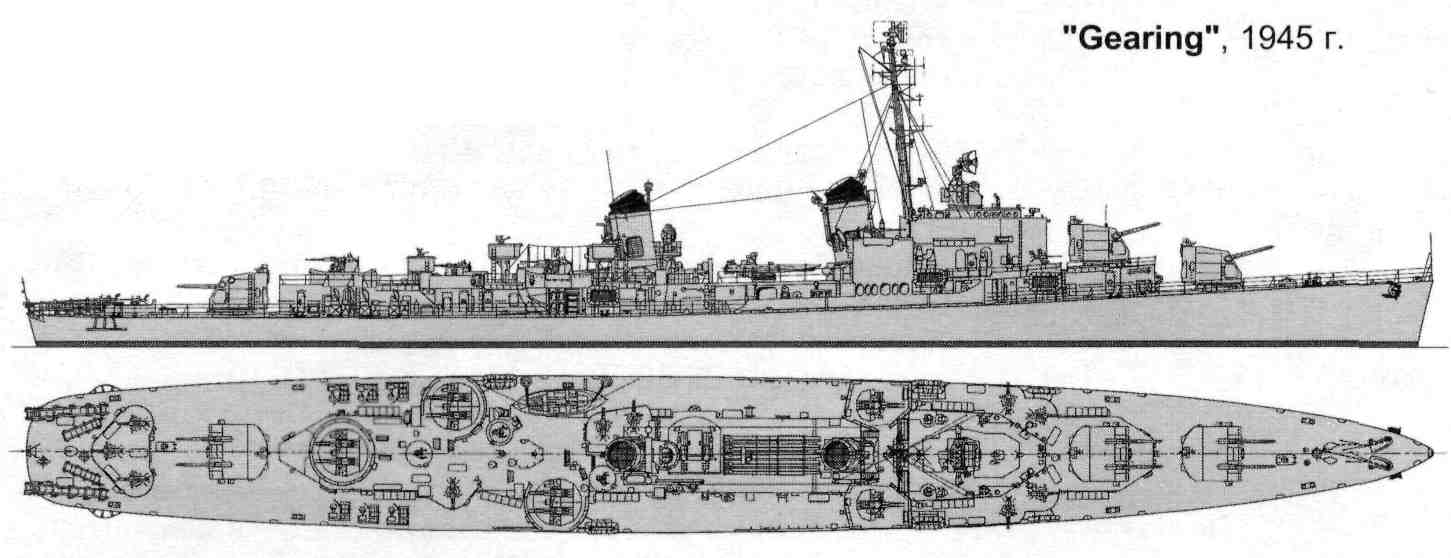
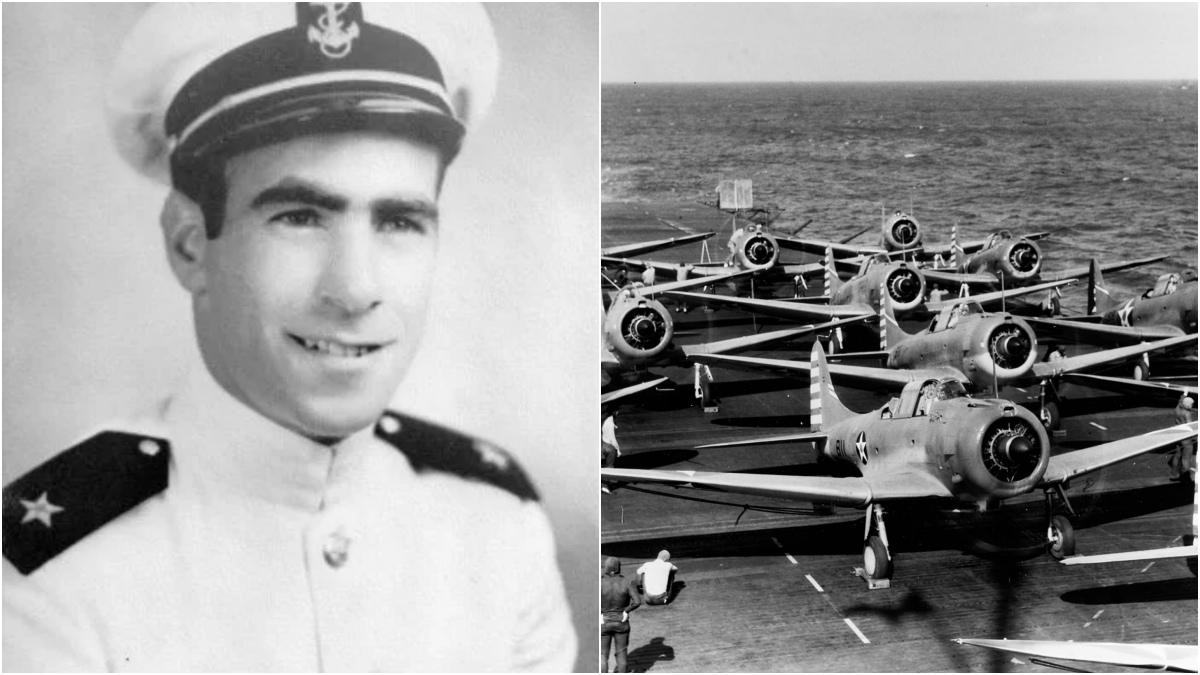




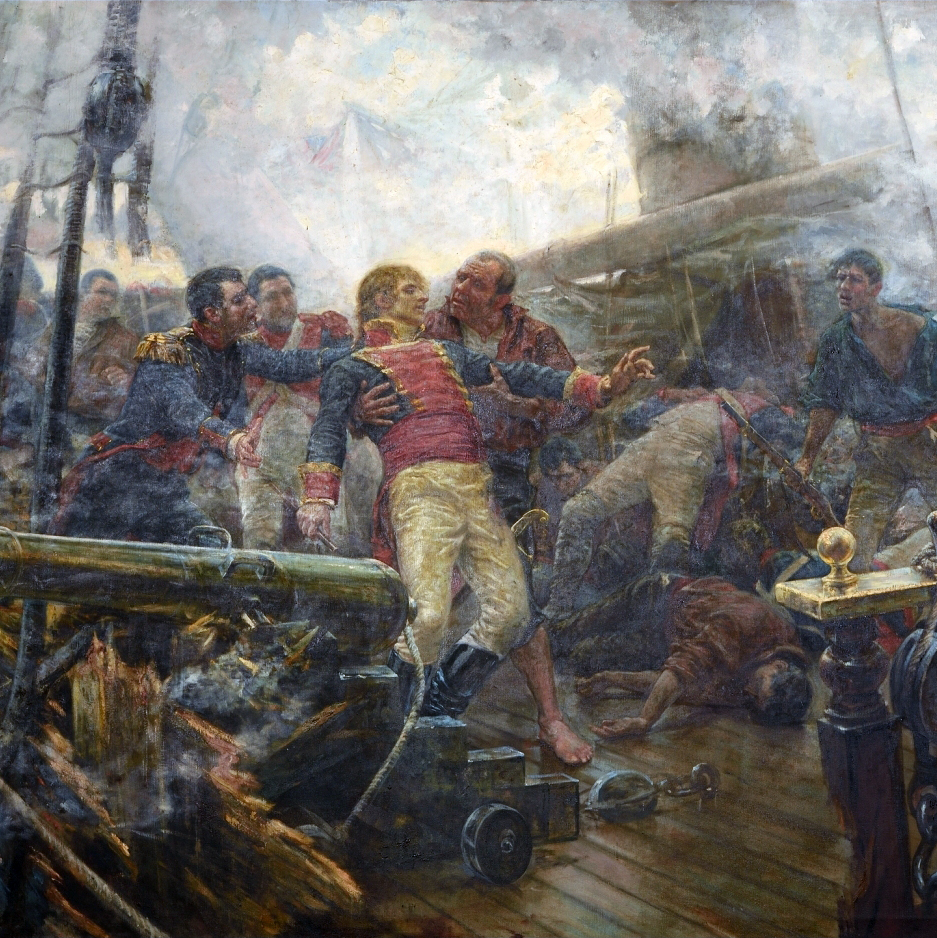
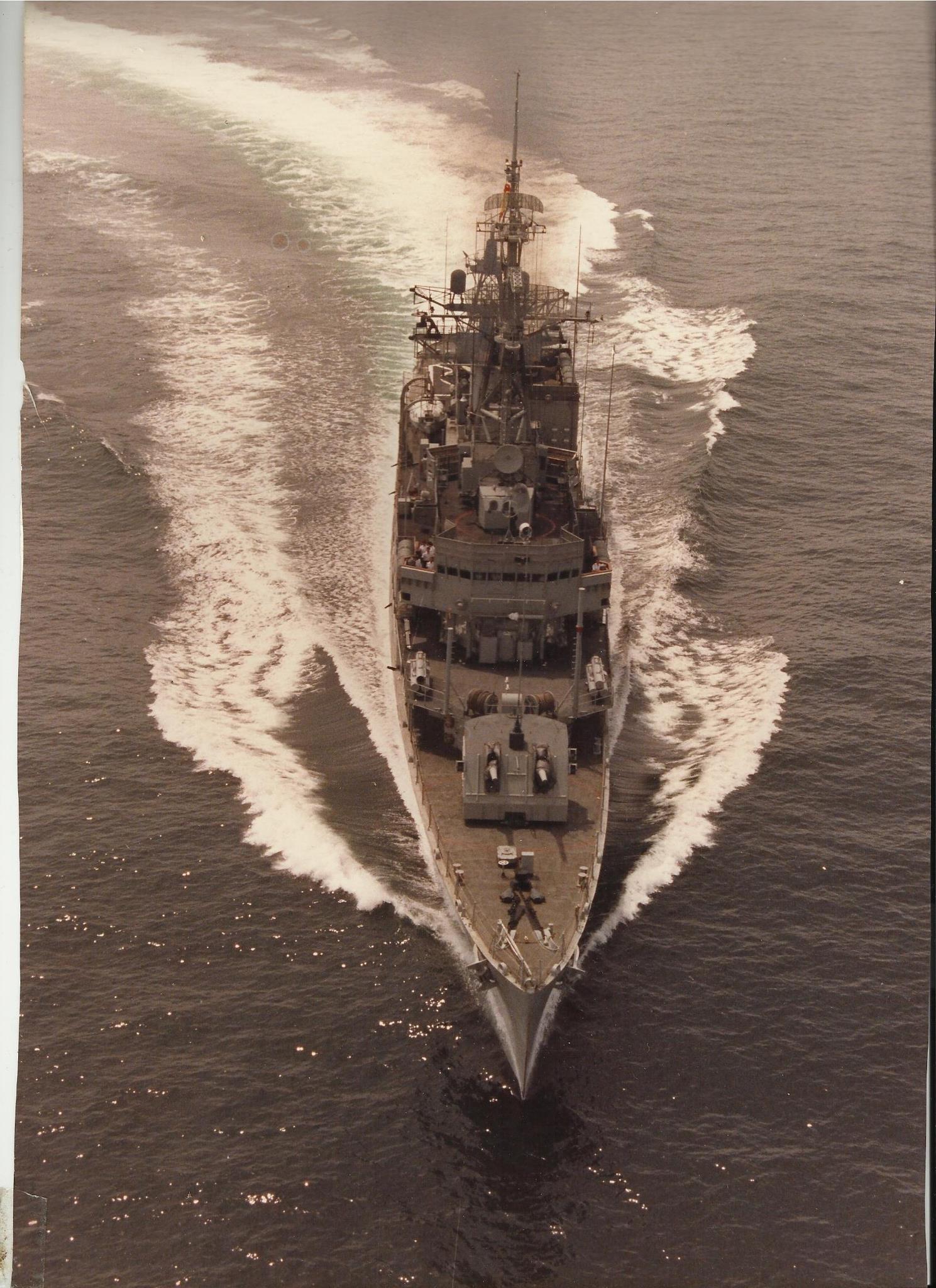
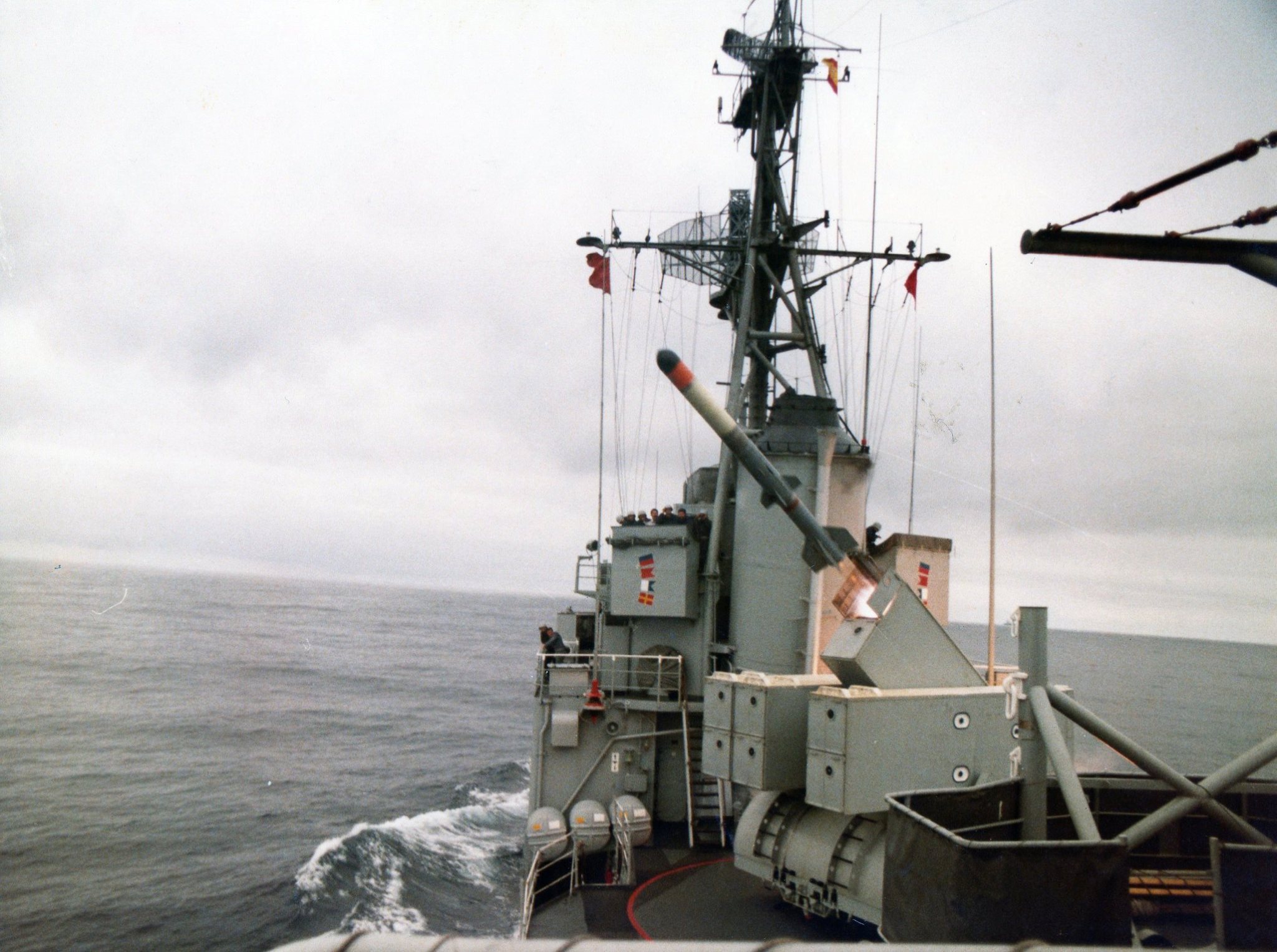

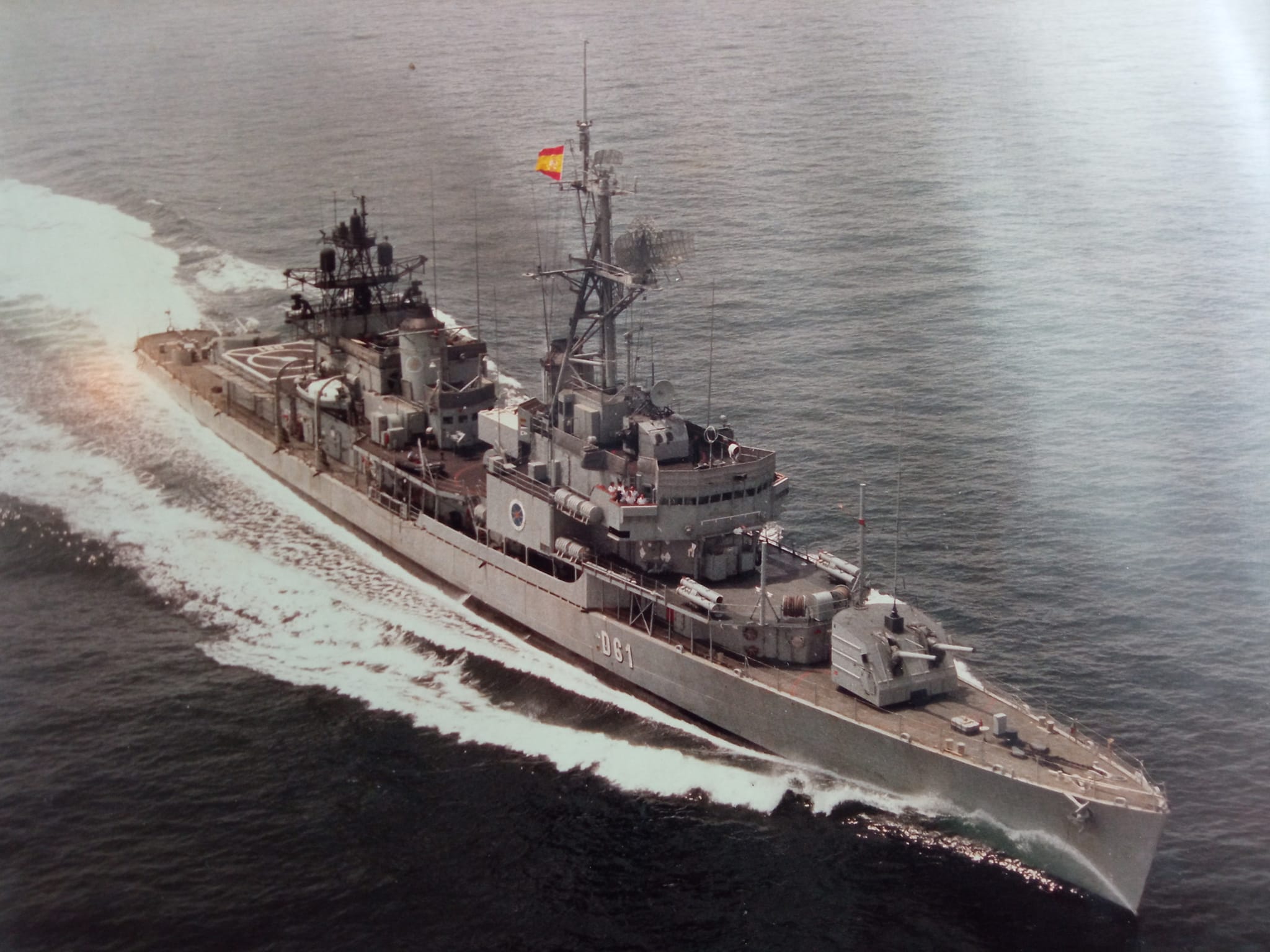
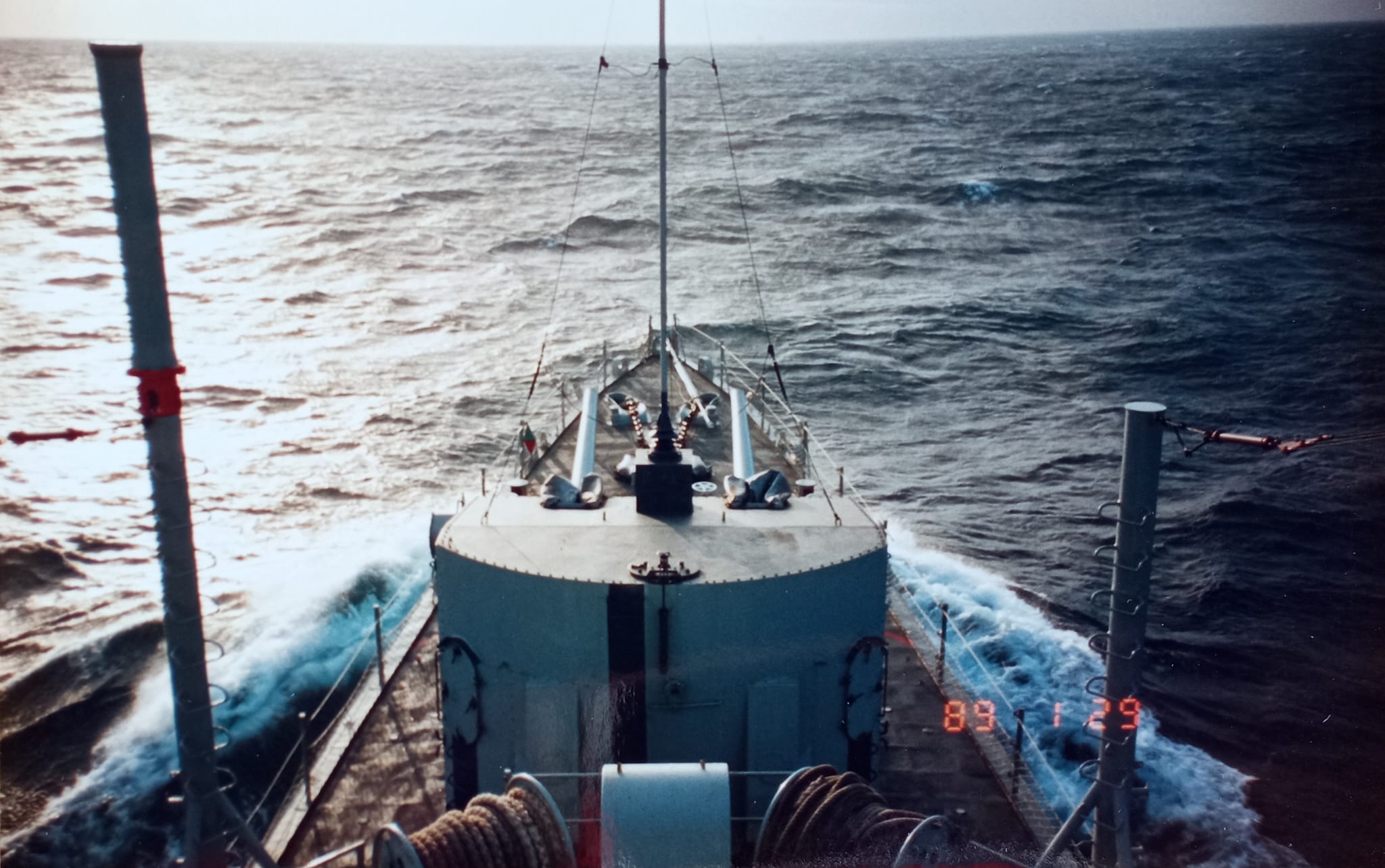

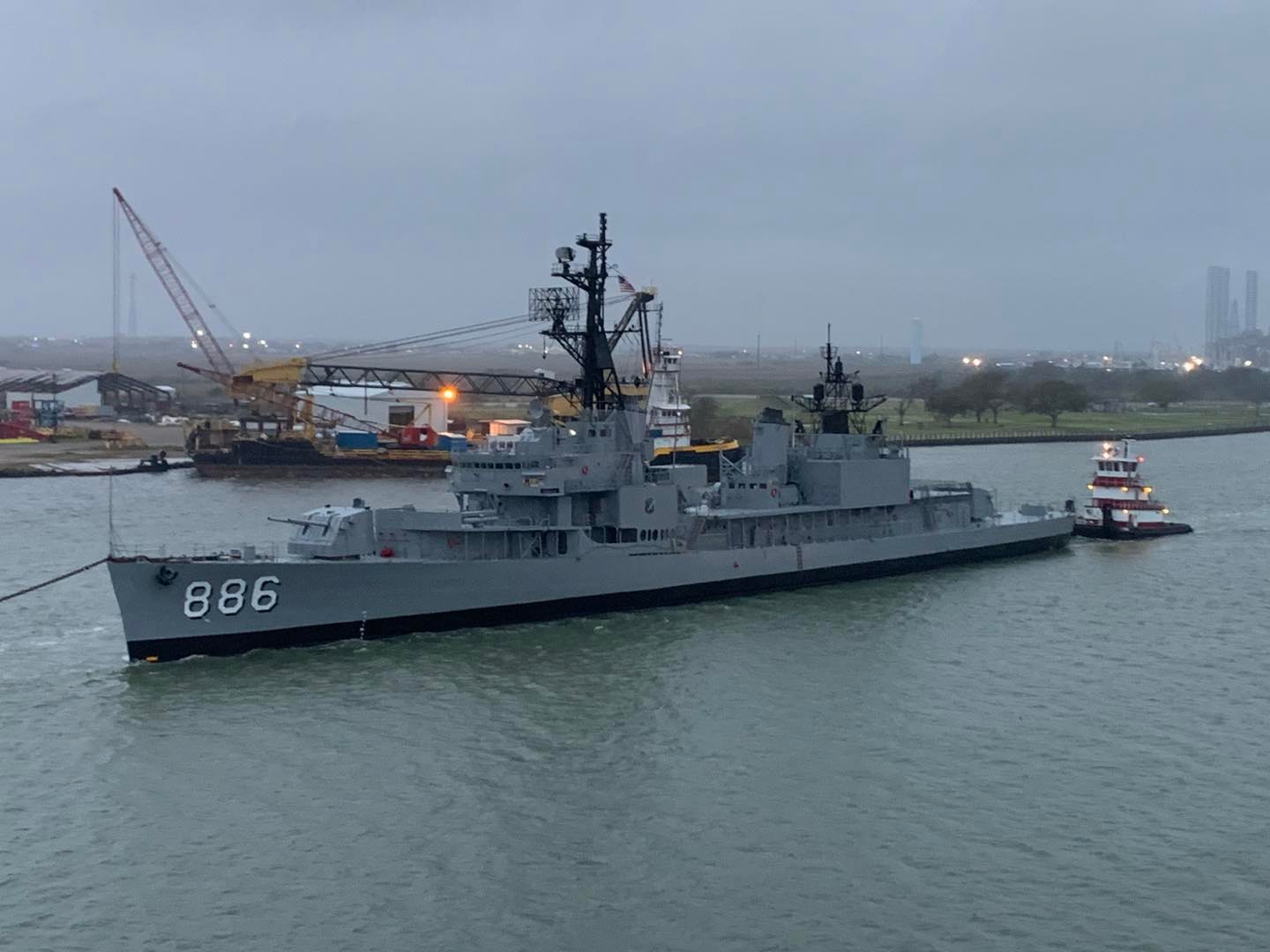
Thank you, Chris! With the Sumners and the Fletchers getting so much of the combat time in WWII, the Gearings can easily be forgotten, but they were amazingly capable for their time, with long legs. Great looking destroyers, too. Thanks for acquainting us with this busy little tin can. It would have been quite something to be onboard with them, off I Corps, during their “crowded hours” of NGFS, at times just a mile from the beach. Wow!
Wishing you fair weather and calm seas!
Bob